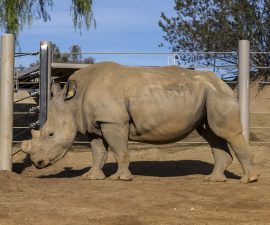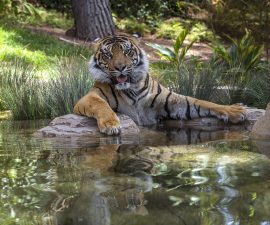Since the news of the death of Nola, a critically endangered 41-year-old northern white rhino who died yesterday at the San Diego Zoo Safari Park was announced, San Diego Zoo Global has received an overwhelming outpouring of sympathy from around the globe.
“There are no words to adequately express the depth of the loss of Nola”, stated Randy Rieches, curator of mammals at the San Diego Zoo Safari Park. “All of us at San Diego Zoo Global are grateful for the outpouring of condolences we have been receiving. Nola was truly an amazing animal and her story resonated with people not only in San Diego, but globally. It is a very difficult time for our staff right now as they have worked with and cared for Nola for 26 years. Our hearts are broken over the loss of Nola and knowing her subspecies is now three individuals from extinction makes it even more difficult for of all of us who work with and love rhinos. But, we are not willing to give up.”
Nola was an iconic animal, not only at the San Diego Zoo Safari Park, but worldwide. She was one of only four northern white rhinoceros on the planet. For those wanting to honor Nola’s memory, please share condolences, favorite photos or thoughts on Facebook using #Nola4Ever. Monetary donations also can be made to the San Diego Zoo Global Rhino Rescue Center at sandiegozoo.org/rhinos to help fund rhino conservation.

Her death moves her subspecies one step closer to extinction with three northern white rhinos remaining: a 43-year-old male, Sudan, and two females, 26-year-old Najin and 15-year-old Fatu, living under human care at the Ol Pejeta Conservancy in Kenya. These rhinos all have reproductive issues.
Keepers had been watching Nola around-the-clock since Nov. 17 when they noticed she began showing signs of a reduced appetite and activity level. Her condition worsened significantly in the early hours of Sunday, Nov. 22, and the Safari Park’s animal care team made the difficult decision to euthanize her.
Nola arrived at the Safari Park in 1989 on a breeding loan from the Druv Kralove Zoo in the Czech Republic. Northern white rhinos were at critically low numbers at the time and San Diego Zoo Global, known for its unprecedented rhino breeding successes, was chosen to try and breed this subspecies. Nola was paired with a northern white rhino male, Angalifu. While the pair bred, Nola never became pregnant. The pair lived in their spacious field habitat at the Safari Park until Angalifu died at the age of 42 in December 2014.
Northern white rhinos have been brought to the brink of extinction due to poaching in Africa. Rhinos are poached for their horn, which is made of keratin—the same material that forms human fingernails. Rhino horn has been erroneously thought to have medicinal value and is used in traditional remedies in some Asian cultures. In addition, objects made of rhino horn have more recently become a “status symbol,” purchased to display someone’s success and wealth, because the rhino is now so rare and endangered.
While the future is bleak for the existing three northern white rhinos, conservationists at San Diego Zoo Global, Druv Kralove Zoo, Ol Pejeta Conservancy and collaborators around the world are holding out hope that they can find a way to save the subspecies. Genetic and reproductive materials from 12 northern white rhinos have been stored in the Frozen Zoo at the San Diego Zoo Institute for Conservation Research, with the hope that new reproductive technologies will someday allow northern white rhinos to be reproduced by having southern white rhinos serve as surrogates. These reproductive technologies may also be applied to other rhino species including the critically endangered Javan rhinos and Sumatran rhinos.
Bringing species back from the brink of extinction is the goal of San Diego Zoo Global. As a leader in conservation, the work of San Diego Zoo Global includes onsite wildlife conservation efforts (representing both plants and animals) at the San Diego Zoo, the San Diego Zoo Safari Park, and San Diego Zoo Institute for Conservation Research, as well as international field programs on six continents. The work of these entities is made accessible to children through the San Diego Zoo Kids network, reaching out through the Internet and in children’s hospitals nationwide. The work of San Diego Zoo Global is made possible by the San Diego Zoo Global Wildlife Conservancy and is supported in part by the Foundation of San Diego Zoo Global.





